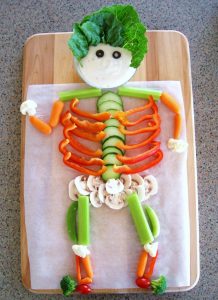 Got veggies? How fun would it be to see a campaign promoting this question? Instead of milk mustaches, perhaps we would see kids creating funny faces using veggies. During National Nutrition Month® I find it fun to inspire people to look at food in a new light. This year, I hope to help people look at fiber in a new light. Fiber is not just some powder mixed in a drink or a brown twiggy type of breakfast cereal. Rather, fiber comes in many forms and flavors such as fruits, veggies, beans, whole grains, nuts and seeds. A high fiber diet is filled with vibrant colors, satisfying flavors and a variety of textures. The possibilities are endless!
Got veggies? How fun would it be to see a campaign promoting this question? Instead of milk mustaches, perhaps we would see kids creating funny faces using veggies. During National Nutrition Month® I find it fun to inspire people to look at food in a new light. This year, I hope to help people look at fiber in a new light. Fiber is not just some powder mixed in a drink or a brown twiggy type of breakfast cereal. Rather, fiber comes in many forms and flavors such as fruits, veggies, beans, whole grains, nuts and seeds. A high fiber diet is filled with vibrant colors, satisfying flavors and a variety of textures. The possibilities are endless!
Many people tend to think of a high fiber diet as one that has no taste. I beg to differ. A high fiber diet has many delicious options. Last week I talked about creative ways to add more fruit to your diet. This week, I challenge you to add more veggies to your weekly menus. An easy way to increase your fiber is to serve starchy veggies such as corn, peas, and sweet potatoes instead of white breads or rice. Corn, peas, and sweet potatoes are called starchy veggies because they contain more carbohydrates per serving compared to other veggies such as carrots, cucumbers, and peppers. However, this is not always a bad thing, because these veggies serve up a large amount of fiber per 1 cup cooked serving. The key is to measure out your serving so that you keep your calories in check while providing your body with excellent fiber. For example, 1 cup of cooked peas has 9 grams of fiber, 1 cup of cooked sweet potatoes has 6.5 grams and 1 cup cooked corn provides 5 grams of fiber. Other high fiber veggies with lower carbohydrate amounts include 1 cup cooked servings of broccoli (5 grams), Brussels sprouts (4 grams), spinach (4 grams) and cauliflower (3 grams).
This week I challenge you to make 1/2 of your plate at meal times filled with veggies. This will ensure that you get plenty of fiber during your meal while keeping your calories low. So how do I prepare veggies, you may ask? The preparations are endless. Veggies can be broiled, grilled, stir-fried, boiled, roasted or simply eaten raw or as part of a salad. Veggies do great with simple marinades of 1 part oil, 2 parts vinegar or juice, and any sort of spices. You can pair the spices to fit your flavor mood. If you are looking for an Italian flare, simply use some olive oil, balsamic or red wine vinegar and oregano, basil, and parsley; for French cuisine, try some olive oil with lemon juice and tarragon, chives, and parsley; if you crave Mexican, pair some canola oil with lime juice and cumin, chili powder, red pepper flakes and cilantro. The possibilities are endless and flavor is abundant!
So are you ready to challenge yourself this week to eat more veggies? How do you plan to increase your veggie intake?

0 Comments